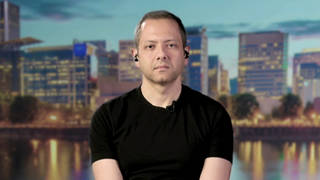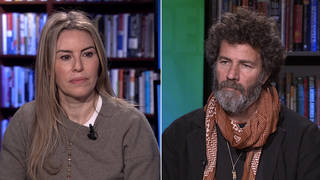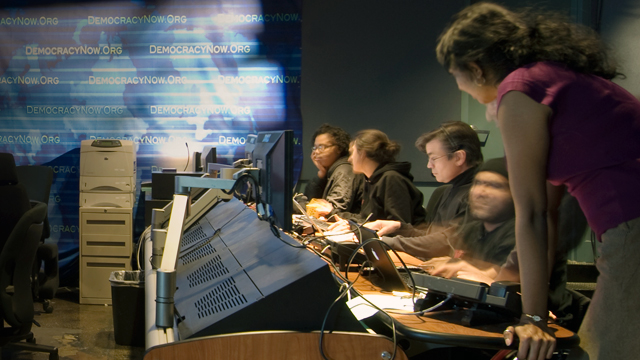
Guests
- Julia Butterfly Hillof North Coast Earth First!
For the last 100 days, environmental activist Julia Butterfly has been perched 180 feet high in a 1,000-year-old redwood tree in Northern California. During the record tree-sitting protest, Julia Butterfly has withstood the heavy rains and blasting 60-mile-per-hour winds of El Niño’s winter storms, as well as harassment from logging company Maxxam Pacific Lumber, which has used searchlights and foghorns to disrupt her sleep.
Transcript
AMY GOODMAN: Well, we want to wish a particular good day today to the person who is out in California who we’re going to turn to right now. For the last 100 days, environmental activist Julia Butterfly has been perched 180 feet high in a 1,000-year-old redwood tree in Northern California. During the record tree-sitting protest. Julia Butterfly has withstood the heavy rains and blasting 60-mile-per-hour winds of El Niño’s winter storms, as well as harassment from logging company Maxxam Pacific Lumber, which has used searchlights and foghorns to disrupt her sleep. We now turn to Julia Butterfly, 180 feet up in a redwood.
Welcome to Democracy Now!, Julia.
JULIA BUTTERFLY HILL: Thank you very much. Hello.
AMY GOODMAN: Well, first, hello. Can you describe where you are?
JULIA BUTTERFLY HILL: Where I am, I am approximately 180 feet up from the base of a over 1,000-year-old redwood tree directly above the town of Stafford, California. I can see the town of Stafford, California, and I can see the Pacific Lumber Scotia mill from where I sit.
JUAN GONZÁLEZ: And, Julia, could you tell us a little bit about what led you to participate in this, such an unusual protest?
JULIA BUTTERFLY HILL: It’s a long story. It began in 1996 when I was in a car wreck that lodged my skull and almost took away — it made me have a problem with being able to walk and talk, and it took almost a year of therapy to make me normal again. And after that, I realized that, you know, I had almost everything that we take for granted taken away. And it made me think that I needed to be doing something different with my life. And I entered the redwood forest and was so overwhelmed by the beauty. And then, when I found out that they were being taken away at an alarming rate, I knew that I had to do something.
And so, I got to the base camp here, that was here in Stafford, California, and found out about what was going on, and they had this tree sit going, and they needed people to sit in it, because it was getting close to the holidays, and everyone was leaving and base camp was closing. And I was like, “I can do it.” I sold everything that I owned to come out here, and I have nothing but time and energy. And so I came up the tree. And that was the beginning of the story.
AMY GOODMAN: We’re talking to Julia Butterfly, 180 feet high. Are you scared of heights, by any chance?
JULIA BUTTERFLY HILL: No. When I was first climbing, it was a little scary, but that’s when I first bonded with this tree that we call Luna, also known as the Stafford Giant. I just looked at the tree, because this tree — redwood trees are amazing with the patterns on the bark, and this tree being so old, there’s lots of scars and lots of interesting patterns. And so, I just looked at the tree instead. And at that point, I lost my fear, and I’ve never had the problem again.
AMY GOODMAN: And what about the storms? How are you holding up with El Niño around?
JULIA BUTTERFLY HILL: El Niño was difficult. And saying — and “difficult,” I think, is a gentle way to talk about El Niño. The worst storm, I had gusts up to 90 miles an hour. A branch from above broke off and collapsed part of my fort. A major branch that I used to get in and out of the fort was ripped off and blown away in the wind. And sleet and hail was ripping — was coming through the ripped tarps. So, it was pretty — it was pretty intense. But it was really an amazing experience to go through and be a part of with a tree, because it really kind of brings about a new understanding about, you know, what it’s like to be a tree outside on a hillside like this that’s coming under attack. And so, made it through it, but it was definitely an intense experience.
JUAN GONZÁLEZ: Now, can you tell us a little bit about the methodology of tree sitting? I mean, are you always out exposed, or is there any covering for you when rain or other — or storms like that hit?
JULIA BUTTERFLY HILL: Yeah, so, this platform is a six-by-eight platform. Then a major branch of Luna comes through the middle of the fort, and then there’s a four-by-eight platform that holds supplies, water, tarps, ropes, things of that nature. And so, the six-by-eight platform is basically the living area. But the whole platform is then covered in tarps. So, normally, just in average weather, you stay pretty dry. But during the storms, the winds were so high that it was ripping the tarps and shredding them. And so that’s why I was getting soaked in the sleet and hail, because the tarps just couldn’t stand up to that intense wind. But usually, like right now, this morning, it’s actually raining here, and right now I’m perfectly dry.
JUAN GONZÁLEZ: And what’s it like at night there? Do you have folks who are providing you supplies, who stay around the clock, or are you basically at night by yourself down there?
JULIA BUTTERFLY HILL: Most of the time up here, I’ve been by myself. Sometimes there’s people that come to visit. Recently, there’s been quite a few reporters, because it’s become a media attention with my record breaking and everything else. But I have an incredible ground support crew, and they’re what resupply me. When I need food or whatever supplies that I need, they resupply me. But most of the time, it’s been by myself.
AMY GOODMAN: Julia Butterfly, as you sit there 180 feet up, I’m sure you have a lot of time to strategize about what is happening there around the redwoods and the battle with Maxxam Pacific Lumber. Can you explain exactly what that is? And then we’ll talk about what they’ve been doing to make it difficult for you to be up there. But can you explain what the battle exactly is about?
JULIA BUTTERFLY HILL: The battle is about a company, Maxxam Corporation, run by Charles Hurwitz, that has come into this area and began completely destroying the environment and the lives of the people in these communities. In the town — the reason this sit is here in particular is because the town of Stafford below me, seven homes were completely destroyed, December 31st, 1996, as a direct result of the logging practices of Pacific Lumber under Maxxam Corporation.
And then there’s the Headwaters Forest that currently is the news with the proposal of the Headwaters deal that we are fighting every step of the way, because what they’re doing is, this man, you know, used a failed — his own savings and loan to purchase junk bonds, and then failed the savings and loan. And so the U.S. tax dollars had to come in and bail out $1.6 billion. And so, this man used part of the money from that high-risk junk bonds to hostilely take over Pacific Lumber. And then he comes in here, and he begins doubling and is now tripling the rate of cut of logging in this area, and going back to the old techniques that have been proven dangerous and unsafe, not only for the environment, but for people’s lives, clear cutting.
And the problem is, is that he’s coming in, he doesn’t care about the forest. He doesn’t care about the habitat that’s in these forests. He doesn’t care about the fact that he’s cutting the last of the old growth that we are left with, less than 3%, and he is cutting the last of that at an alarming rate. And he doesn’t care about the people’s lives that he’s destroying in the process. And so, a lot of people in the local communities and from across the country, and now around the world, are saying, “No, that’s not right. You know, this is — you can’t — you can’t take people’s lives, and you can’t take the life of the environment and base it on the dollar, because the quality of the life of our environment and the quality of the lives of our people are worth more than the dollar that’s going into his hands.” And that’s where the conflict is coming.
AMY GOODMAN: We’re talking to Julia Butterfly, who is protesting Maxxam Pacific Lumber’s cutting down of redwood trees. And she is 180 feet high in one of those redwoods in the Headwaters area. Julia, you have survived some amazing tests of courage and actually withstood numerous threats to your life during your protest. In December, trees were felled dangerously close to you. That was followed by aerial log removal by a Columbia twin-prop helicopter. What happened there?
JULIA BUTTERFLY HILL: That was — that was pretty intense. They broke FAA regulations the very first day, coming trying — in an effort to rip the tarps off and scare me down. And then, when that didn’t work, they just proceeded with their operations. And these helicopters, they used because, in their own words, it is a gentler form of logging than cutting more roads into the hillside, because that is — the road building and then the clear cutting on this hillside is what caused the mudslide. So, they’re saying, “OK, we’re going to come in and helicopter log.”
But, unfortunately, helicopter logging is no more gentle. And I didn’t know that until I was up here experiencing it. And what it does, it has updrafts of up to 300 miles an hour, and it completely twists the tops and shreds the tops of these trees. Half of the trees on this hillside no longer even look like trees, the ones that are still standing, because the updraft has ripped them apart. Therefore, it’s killed any nesting birds or any animals that live in these trees. They’re gone now. And the updrafts are so strongly that it’s actually ripped some trees out of the ground. So, these helicopters are extremely destructive to the hillside. And they basically — they pull the logs off of the hillside that have been felled. And a couple of times, the logs have been very, very close, when they’re flying in the air, to my front door, to my tree.
JUAN GONZÁLEZ: Now, what’s been the attitude of the Clinton administration and that renowned environmentalist Al Gore to this situation? Could you tell us about what the — your view of how the federal government is reacting to this?
JULIA BUTTERFLY HILL: The federal government is standing up true in its typical way, and it’s holding fast to the injustice of our justice system. The federal government has proposed — has been a part of this Headwaters deal that is proposing to pay a thief. Charles Hurwitz is currently under investigation for the failed savings and loans, and two of the people that were involved with him in this takeover have already been convicted in federal court. So, because Mr. Hurwitz has all this money, he’s managing to stay one step ahead. But he is still being — he’s still in court, being looked at for this failed savings and loan, the fact that he, you know, is basically a thief, stole the U.S. money and is currently making millions off of it. So, they’re proposing to pay this already-known thief more money for land that shouldn’t be his to begin with.
And then they’re proposing a Habitat Conservation Plan in this deal that allows the company to make their own Habitat Conservation Plan, saying what’s a good — what’s good for the environment here, as well as for their company. But Pacific Lumber has racked up 200 violations, 200 violations of the environmental laws, and yet this Headwaters deal says, “Well, that’s OK. Go ahead. We’re still going to trust you to write up a Habitat Conservation Plan that will take care of the environment.” And on top of that, then the Habitat Conservation Plan only has to last 50 years, and then after 50 years, they’re free to do whatever they want again. And that’s really [inaudible] already is destroy stream habitat. They’ve destroyed — you know, the coho salmon, the marbled murrelet and the spotted out are all part of the habitat that we’re fighting for, because they’re all threatened and endangered. And at the rate that Pacific Lumber is going, they’re going to be extinct.
AMY GOODMAN: Julia Butterfly, Maxxam ordered 24-hour security to use searchlights and foghorns to disrupt your sleep. Was it difficult then? And also threatened to or vowed to starve you out, until 20 people from Earth First! hiked to the tree and nonviolently broke the blockade and resupplied you, which ultimately forced security to give up there.
JULIA BUTTERFLY HILL: Yes, well, it was really difficult when they were here, because they came right as the beginning of the worst of the El Niño storms came. And so, they were doing the foghorns and the bugles, and they had dogs barking. They were, you know, trying to deprive me of sleep. And so, sleep deprivation is actually a hard thing, especially when you’re dealing with winter storms and trying to maintain a sit. But, you know, it was a great experience. All of these things to me are, you know, a good experience, because I’ve learned from them, and I’ve found ways to withstand them.
AMY GOODMAN: Well, as we wrap up today, I understand that today, on your hundredth day in the redwood, that two groups will be honoring you. The Veterans for Peace will be presenting you with the Wage Peace Recognition of Valor, and the Leonard Peltier Defense Committee will be presenting you with the first annual Leonard Peltier Protector of the Woods Award. How will they reach you?
JULIA BUTTERFLY HILL: Well, there’s going to be a rally in the town of Stafford at the base of the mudslide today, and they’re going to —
AMY GOODMAN: We’re hoping that we didn’t — Julia?
JULIA BUTTERFLY HILL: Yes?
AMY GOODMAN: Go ahead. And?
JULIA BUTTERFLY HILL: OK, yes, they’re going to present it to my group, Earth First!, on behalf of myself and behalf of the forest and behalf of Earth First!, that’s working really hard to make a change here.
AMY GOODMAN: When do you plan to come down?
JULIA BUTTERFLY HILL: I don’t know that. As long as I can continue to be a voice for these forests that can’t speak, and as long as I can continue to be a voice for these people who should have been heard by the government a long time ago, I’m going to stay here. You know, what I’ve been through is small compared to what the people of these communities and what these forests are going through, and what people like Leonard Peltier are going through. I’m dedicating the 15th through the 27th of my sit to him to try and have him released from prison, because he’s been wrongfully in prison for 22 years. So, the things I’ve been through are small compared to the things that everyone else is going through that are involved with this government of power lust and greed.
AMY GOODMAN: Well, Julia Butterfly, we want to thank you for joining us. I understand you have a phone number and also a website. By the way, we’re speaking to Julia on a cellphone up 180 feet high in her perch in the redwood called Luna.
JULIA BUTTERFLY HILL: Yes. You do have the information on the number and the website?
AMY GOODMAN: Do you have the website?
JULIA BUTTERFLY HILL: Yes, yes. Well, I wasn’t sure if you were saying you had it, or if I knew and should give it.
AMY GOODMAN: No, why don’t you go ahead and give it?
JULIA BUTTERFLY HILL: OK. I’m finding it here, all my information. The website number is www.NorthCoast.com/~sohum/luna. And that will give people information not only on this tree sit, but on the Headwaters deal and all the information [inaudible] —
AMY GOODMAN: And the phone number?
JULIA BUTTERFLY HILL: — that’s going on. 707 —
AMY GOODMAN: 707.
JULIA BUTTERFLY HILL: 445 —
AMY GOODMAN: 445.
JULIA BUTTERFLY HILL: 3344.
AMY GOODMAN: That’s 707-445-3344.
JULIA BUTTERFLY HILL: Yes. And also, if they can’t reach through on that number, the same area code, 707-445-5105.
AMY GOODMAN: That’s 707-445-5?
JULIA BUTTERFLY HILL: 105.
AMY GOODMAN: 5105. Thank you very much, Julia Butterfly, and we do look forward to checking back with you soon.
JULIA BUTTERFLY HILL: Thank you so much for having me. I appreciate it.
AMY GOODMAN: Thank you very much, Julia Butterfly, in a tree in Headwater, California. You are listening to Pacifica Radio’s Democracy Now! We move from one protest to another. When we come back, we’ll find out about people in Berkeley, California, who are fighting corporate control of the schools. And then we’ll take a look at the worst massacre in Puerto Rican history. Stay with us.
[break]
AMY GOODMAN: And you’re listening to Pacifica Radio’s Democracy Now!, The Exception to Rulers. Yes, I think Julia Butterfly is knocking on heaven’s door as she sits up there, 180 feet high. Quite amazing. I’m Amy Goodman, here with Juan González. Juan, do you think you could do it?
JUAN GONZÁLEZ: Oh, no, I’ve got a problem with heights, Amy. Except on airplanes, I manage to get along fine.
AMY GOODMAN: Wow!













Media Options